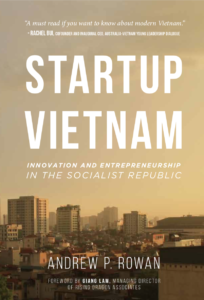Sign up to our newsletter to get updates on new articles.
The following is an edited excerpt from Startup Vietnam: Innovation and Entrepreneurship in the Socialist Republic by Andrew P. Rowan.
In 2012, the lotus became Vietnam’s national flower after a nationwide vote held by the Ministry of Culture, Sport, and Tourism of Vietnam (MCST). The lotus, adored by many Vietnamese, is found only in muddy waters and has unique origins. Often hidden within murky waters, a lotus slowly grows then blooms with a beautiful flower: similarly, within Vietnam’s grand environmental challenges, lie enticing opportunities.
Deputy Prime Minister and Foreign Minister of Vietnam, Phạm Bình Minh, said at The Economist’s Vietnam Summit 2016 that the “driver for [economic] growth is approaching its limits, so it requires a new growth model.” That new growth model—and its powers—is slowly taking shape as Vietnam tries to chart a new course away from low-wage manufacturing—and toward sustainable and renewable sources of energy.
Much of Vietnam’s economic growth has been fueled by coal. Electrification rates in the nation were at 98% in 2013, up from 2.3% in 1975, according to the World Bank. In 2014, the World Bank recognised Vietnam as having the highest rural electrification ratio in the world among developing countries. However, it has come at a price: Vietnam’s per capita carbon emission levels grew five times from 1990 to 2013. However, this trend is being supplanted at a global scale: humanity’s contribution to climate change is being replaced by taking climate action and building climate resilience.
In 2015, world leaders gathered in Paris at the twenty-first Convention of Parties to the United Nations Framework Convention on Climate Change (COP21) to make a historic commitment. A total of 196 signatories pledged to “pursue efforts to limit the temperature increase to 1.5 °C above pre-industrial levels, recognising that this would significantly reduce the risks and impacts of climate change.”
To help developing nations such as Vietnam transition from fossil fuels to greener sources of energy, developed countries will provide USD 100 billion per year in the form of the Green Climate Fund (GCF) and other finance vehicles yet to be finalised. During COP21, Vietnam also pledged USD 1 million to the GCF, from 2016 through 2020, while continuing to “implement the national strategy, program, and plans in response to climate change in various areas with concrete measures.” Vietnam’s Intended Nationally Determined Contribution (INDC) calls for an 8% reduction in greenhouse gas emissions by 2030 compared to business-as-usual (BAU) projections, and with international support, up to 25%.
Vietnam’s growing energy needs are an opportunity to invest in green technologies—and to use new technologies to mitigate the limitations of current renewable energy sources, such as hydro power during the wet season (which sometimes contribute to landslides or floods). As the US looks inward on a streak of economic nationalism, China seems to have taken the lead on green energy. In other words, if the United States doesn’t lead in clean energy and renewables, then other nations will. Vietnam could—and should— be among them.
In 2015, Vietnam had 16,882 megawatts of renewable electricity-generating capacity, according to the International Renewable Energy Agency (IRENA), and it produced 66,489-gigawatt hours of renewable electricity in 2014, primarily in the form of hydropower. Notably, for 2017, Vietnam received a score of 78 by Regulatory Indicators for Sustainable Energy (RISE),which examines a country’s regulations and policies in the energy sector, ranking Vietnam among the top thirty countries in the world and the top in Southeast Asia. While Vietnam performed well in the areas of energy access and energy efficiency, there was room for improvement in renewable energy. However, in early 2017, Vietnam’s prime minister, Nguyễn Xuân Phúc, approved the first solar law, Decision No. 11/2017/QĐ-TTg, supporting the development of solar power projects in Vietnam, enabling a new stage of renewable energy investments in Vietnam. This shift in power policy isn’t just good for Vietnam’s economy; it could help reduce carbon emissions, thereby mitigating a rising sea level, which Vietnam is particularly vulnerable to.
According to the UNDP Human Development Report 2007–2008, twenty two million Vietnamese could be at risk of being temporarily or permanently displaced if global temperatures rise 3°C to 4°C. As global temperatures increase, so does the sea level, producing stronger, more frequent storms. The Mekong Delta, home to 20% of Vietnam’s population, and 50% of its rice production is at risk of going under as sea levels penetrate farther inland. The Red River Delta, encompassingHanoi, has also experienced saltwater intrusion.
Cần Thơ, the largest city in the Mekong Delta and the fourth largest city in Vietnam with a population of 1.1 million, is 0.8 meters above sea level, situated sixty-five kilometers from the ocean. A one-meter sea-level rise could displace up to seven million people, according to a study by the UN Refugee Agency (UNHCR), the Columbia University Center for International Earth Science Information Network, and other groups. A two-meter sea-level rise could double the number of internally displaced persons (IDP).
Simply, Vietnam is among the most threatened countries in the world regarding the effects of climate change, making it ever vital for Vietnam to lead climate actions. Radical challenges, such as Hanoi enjoying only 28 days of clean air in 2017, according to Green Innovation and Development Center, need radical solutions. Reliance on coal power will make it increasingly difficult for Vietnam to meet its obligations under the Paris Climate Agreement. According to the World Resources Institute,“Vietnam set a target to achieve 25% renewables in its energy mix by 2030 and 45% by 2050.”
On renewable sources of energy, according to the Vietnam Net Bridge, “the Vietnamese government’s targets, solar power is expected to become the main new renewable energy source in the future. The Solutions Project, based at Stanford University, has already mapped out how to transition Vietnam to 100% wind, water, and solar (WWS) energy for all purposes (electricity, transportation, heating/ cooling industry) by 2050. It’s a good start, but Vietnam can and should be even more aggressive in achieving and implementing its green energy plan.
In one scene of Before the Flood, a film produced by actor and United Nations Messenger of Peace, Leonardo DiCaprio, Tesla’s founder and CEO, Elon Musk, and DiCaprio are walking through the Tesla Gigafactory in Storey, Nevada, which produces batteries and on completion will be the largest building in the world. DiCaprio asks Musk, “How is [the Gigafactory] going to help developing nations that have massive populations that need to have power?”
Musk responds, “The advantage of solar and batteries is that you can avoid building electricity plants at all. So you could be a remote village and have solar panels that charge a battery pack that then supplies power to the whole village without ever having to run thousands of miles of high-voltage cable all over the place. It’s like what happened with landline phones versus cellular phones.”
Musk goes on to explain that just one hundred Gigafactories would fulfil all of the earth’s energy needs. So, could a Gigafactory be in Vietnam’s future? Tesla’s Gigafactory is estimated to cost USD 5 billion and is expected to produce USD 100 billion in economic impact for Nevada over the next twenty years. Could some of Vietnam’s inward remittances be diverted to investment vehicles, investing in the future of the country by enabling its people to become social and financial stakeholders in a greener, cleaner, and healthier Vietnam?
While solar energy isn’t viable throughout Vietnam and its electrification rate is among the highest, infrastructure is already in place to leverage new green technologies and offset the dangerous, dirty effects of coal-generated electricity via Tesla Powerwalls and other renewable sources of energy.
Happy Planet Index (HPI) ranked Vietnam fifth in the world and first in Asia-Pacific with a score of 40.3 gauging well-being, life expectancy, inequality of outcomes, and ecological footprint. The HPI noted that Vietnam’s ecological footprint was smaller than it should be, given the size of its economy, but pointed out that Vietnam has some important choices ahead as its economic growth projection on urbanization continues to increase, and people consume more products and services. If it follows a standard development path, then its ecological footprint will increase, driving the country’s HPI down.
According to the United Nations, by 2050, two-thirds of humanity will live in cities, the majority of which will be in Asia. Sixty percent of the world’s population already live in Asia. By 2050, the global population will be 9.7 billion, with two billion elderly—1.3 billion of which will be in Asia-Pacific, according to the World Economic Forum. Vietnam is in both groups: in 2009, 10% of Vietnam’s population was sixty or older, but by 2034, there will be one elderly person for every child in Vietnam. In other words, in 15 – 20 years, the elderly will make up more than one-third of Vietnam’s population. Around 2047, there will be more elderly than children in Vietnam, according to the 2014 Vietnam Intercensal Population and Housing Survey: Population Sex-Age Structure and Related Socioeconomic Issues in Vietnam,produced by the General Statistics Office (GSO) and United Nations Populations Fund (UNPF). This increase in an elderly population means that Vietnam’s urban designers and architects will need to think quite differently about mobility challenges in the future.
Today, Vietnam is home to the sixth-largest urban population in East Asia, with 23 million city dwellers. Ho Chi Minh City has already become Vietnam’s first megacity reaching a population of over 10 million. Hanoi isn’t far behind. If both cities’ current growth rates are maintained at 4.0% and 3.8% respectively, by 2020, they will both be twice as large as they were in 2000. The urban expansion of these cities is greater than any other area in the region, except for China. Already, in Hanoi’s densest areas, such as Hoàn Kiếm District, population density exceeds 40,000 per square kilometer in 2010, according to the World Bank.
The infrastructure investments made today will remain in place for 20 or 30 years. If Vietnam invests in coal, it may come at a low price today but with large direct and indirect costs for Vietnam’s future. However, if Vietnam invests in solar, wind, hydro, and so on, then it will lead the way in transitioning from fossil fuels, saving the lives of its citizens in the process. The good news is that by 2020, the cost of renewable energies such as wind and solar will be less than that of fossil fuels, according to the International Renewable Energy Agency.
The public sector has a role to play in promoting a more mindful approach to environmental and social considerations, and Vietnam’s policymakers see the potential for social impact and purpose from the private sector. In 2015, Decree 96 (No. 96/2015/NĐ-CP) was issued,which stated in Article 2, “The State shall encourage and create conditions for organizations and individuals to establish social enterprises to operate for the purpose of solving social and environmental issues in the interest of the community.” The Vietnam Enterprise Law 2014 (Law No. 68/2014/QH13) outlines the obligations of a social enterprise, with an objective to resolve social or environmental problems, or to serve public interests, in Article 10, section C, which maintains that “at least 51% of annual profit is used for reinvestment in order to serve the social, environmental purposes as registered.”
This definition of a social enterprise may prove too narrow, but overall, it’s important to note that there are increasing options for those who want to focus on social entrepreneurship in Southeast Asia, notably in Indonesia, the Philippines, and Vietnam. For now, social enterprises are clustered in major cities in Vietnam, according to The Landscape for Impact Investing in Southeast Asia report by the Global Impact Investing Network (GIIN) and Intellecap Advisory Services. Doing good is no longer limited to charities and NGOs. In January 2018, Laurence D. Fink, founder and CEO of BlackRock, which manages USD 6 trillion in investments, wrote to business leaders, “Society is demanding that companies, both public and private, serve a social purpose,” and stipulated that businesses would need to contribute to society in order to receive the firm’s support.
In November 2016, Vietnam’s government cancelled plans for its first nuclear power plants due to environmental and financial concerns, a sign that it is aware of growing citizen engagement in the area of environmental safety. This comes especially after the Formosa crisis in central Vietnam wreaked havoc on the livelihoods of fishermen, resulting in a USD 500 million fine for the Taiwanese firm. The country’s “21st century energy plan” is still developing. A brighter future awaits, powered by clean and renewable energy; the timing is ripe to commit and dispel the renewable energy myths in Vietnam. Hopefully, Vietnam’s contribution to ocean pollution will be addressed concurrently. Out of the 8 million metric tons of plastic that are dumped into the oceans each year, five countries contribute up to 60% of this pollution, including Vietnam, according to a 2015 study published in Science.
Startups may not be the answer for some of these challenges, but the startup mindset and a different approach from “business as usual” can contribute to a culture of materialising cross-sector efforts spearheaded by innovative models with an engaged populace. That would be the biggest opportunity of all in Vietnam: a chance to save and improve lives.
Andrew P. Rowan is an American entrepreneur, the host of the Planetary Potential, and the author of Startup Vietnam: Innovation and Entrepreneurship in the Socalist Republic (Mascot Books, 2019).
The excerpt is provided by courtesy of the publisher, Mascot Books. You can order a copy of the newly released book here. (Receive 10% off and free shipping in the USA with the code “AsianPioneers”.)
Copyright © 2019 Andrew P. Rowan. Excerpted by permission of Mascot Books. All rights reserved. No part of this excerpt may be reproduced or reprinted without permission in writing from the publisher.
Sign up to our newsletter to get updates on new articles.






